Opportunities for Volvo in the European Electric Car Market
VerifiedAdded on 2023/01/11
|12
|2801
|62
AI Summary
This report provides a strategic analysis of the European market and explores the opportunities for Volvo to enter and capture a large market share with its electric car technology. It includes a company overview, PESTLE analysis, Porter's five forces analysis, product life cycle analysis, and Porter's value chain model.
Contribute Materials
Your contribution can guide someone’s learning journey. Share your
documents today.
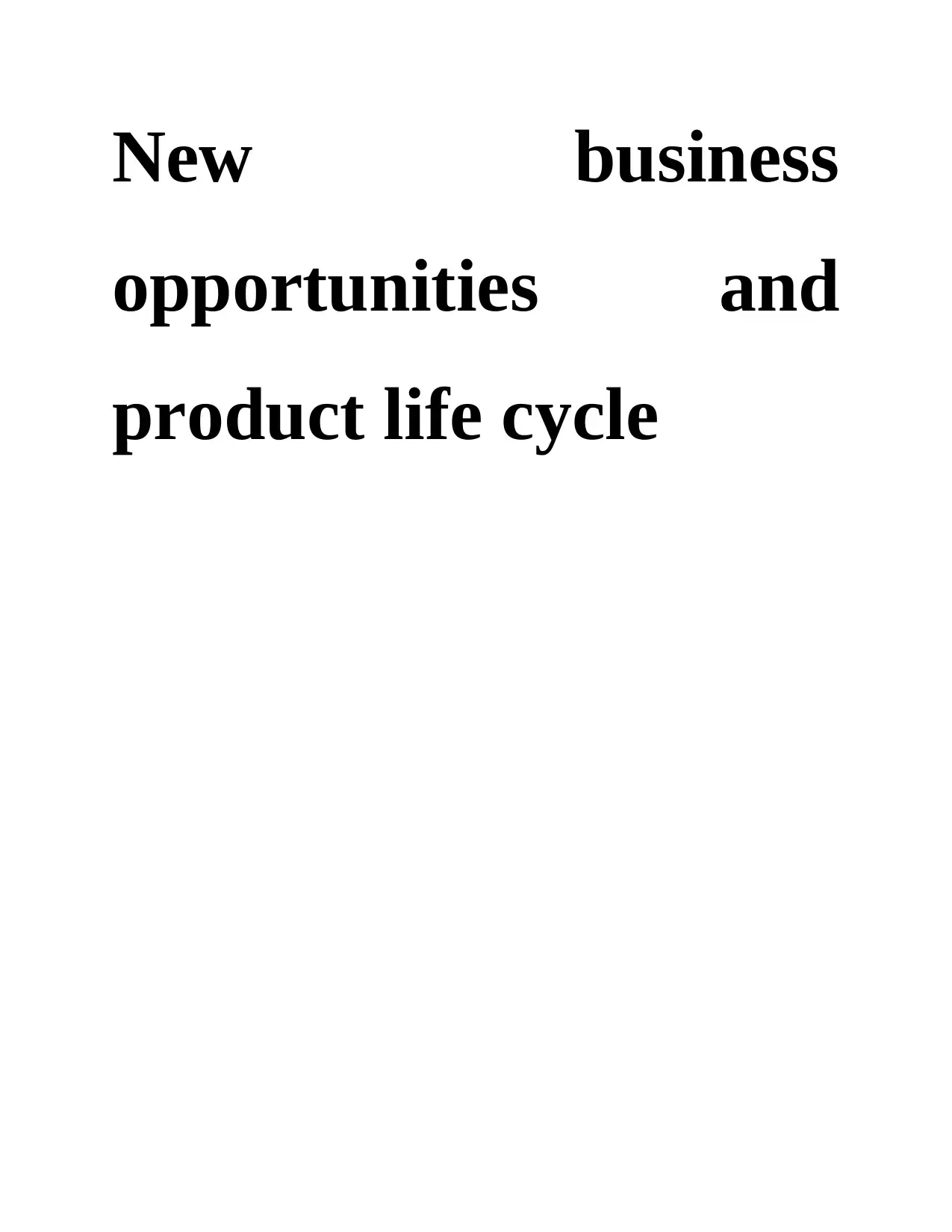
New business
opportunities and
product life cycle
opportunities and
product life cycle
Secure Best Marks with AI Grader
Need help grading? Try our AI Grader for instant feedback on your assignments.
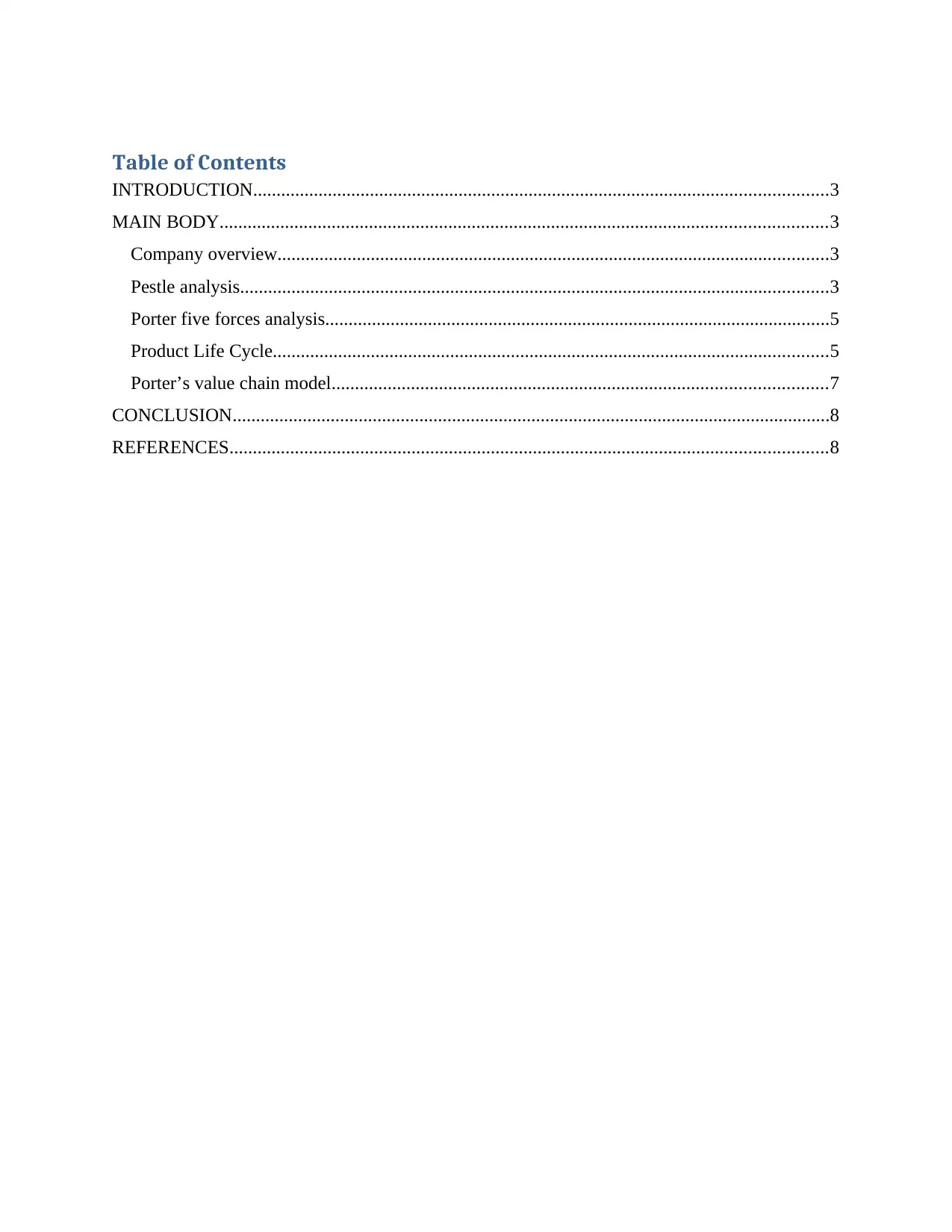
Table of Contents
INTRODUCTION...........................................................................................................................3
MAIN BODY..................................................................................................................................3
Company overview......................................................................................................................3
Pestle analysis..............................................................................................................................3
Porter five forces analysis............................................................................................................5
Product Life Cycle.......................................................................................................................5
Porter’s value chain model..........................................................................................................7
CONCLUSION................................................................................................................................8
REFERENCES................................................................................................................................8
INTRODUCTION...........................................................................................................................3
MAIN BODY..................................................................................................................................3
Company overview......................................................................................................................3
Pestle analysis..............................................................................................................................3
Porter five forces analysis............................................................................................................5
Product Life Cycle.......................................................................................................................5
Porter’s value chain model..........................................................................................................7
CONCLUSION................................................................................................................................8
REFERENCES................................................................................................................................8
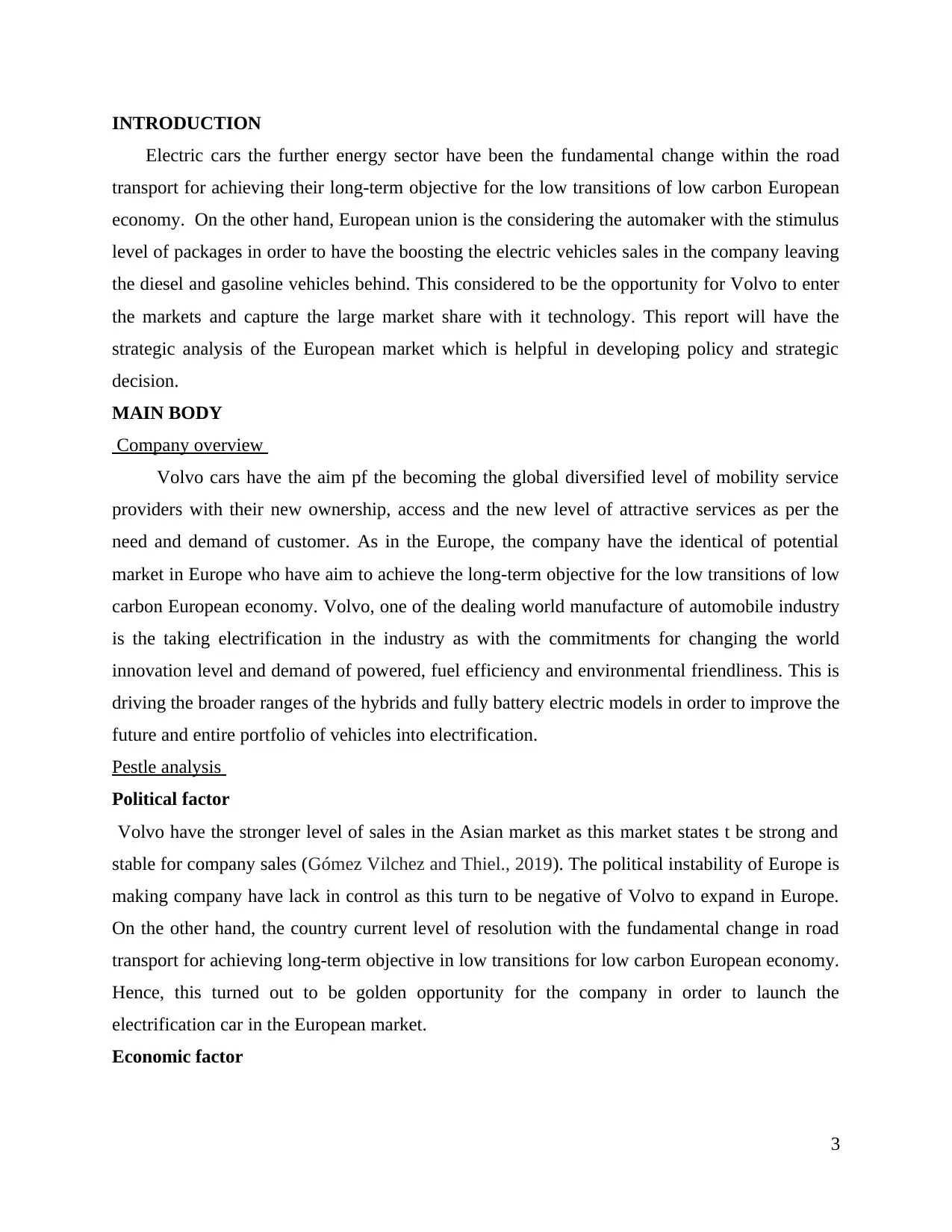
INTRODUCTION
Electric cars the further energy sector have been the fundamental change within the road
transport for achieving their long-term objective for the low transitions of low carbon European
economy. On the other hand, European union is the considering the automaker with the stimulus
level of packages in order to have the boosting the electric vehicles sales in the company leaving
the diesel and gasoline vehicles behind. This considered to be the opportunity for Volvo to enter
the markets and capture the large market share with it technology. This report will have the
strategic analysis of the European market which is helpful in developing policy and strategic
decision.
MAIN BODY
Company overview
Volvo cars have the aim pf the becoming the global diversified level of mobility service
providers with their new ownership, access and the new level of attractive services as per the
need and demand of customer. As in the Europe, the company have the identical of potential
market in Europe who have aim to achieve the long-term objective for the low transitions of low
carbon European economy. Volvo, one of the dealing world manufacture of automobile industry
is the taking electrification in the industry as with the commitments for changing the world
innovation level and demand of powered, fuel efficiency and environmental friendliness. This is
driving the broader ranges of the hybrids and fully battery electric models in order to improve the
future and entire portfolio of vehicles into electrification.
Pestle analysis
Political factor
Volvo have the stronger level of sales in the Asian market as this market states t be strong and
stable for company sales (Gómez Vilchez and Thiel., 2019). The political instability of Europe is
making company have lack in control as this turn to be negative of Volvo to expand in Europe.
On the other hand, the country current level of resolution with the fundamental change in road
transport for achieving long-term objective in low transitions for low carbon European economy.
Hence, this turned out to be golden opportunity for the company in order to launch the
electrification car in the European market.
Economic factor
3
Electric cars the further energy sector have been the fundamental change within the road
transport for achieving their long-term objective for the low transitions of low carbon European
economy. On the other hand, European union is the considering the automaker with the stimulus
level of packages in order to have the boosting the electric vehicles sales in the company leaving
the diesel and gasoline vehicles behind. This considered to be the opportunity for Volvo to enter
the markets and capture the large market share with it technology. This report will have the
strategic analysis of the European market which is helpful in developing policy and strategic
decision.
MAIN BODY
Company overview
Volvo cars have the aim pf the becoming the global diversified level of mobility service
providers with their new ownership, access and the new level of attractive services as per the
need and demand of customer. As in the Europe, the company have the identical of potential
market in Europe who have aim to achieve the long-term objective for the low transitions of low
carbon European economy. Volvo, one of the dealing world manufacture of automobile industry
is the taking electrification in the industry as with the commitments for changing the world
innovation level and demand of powered, fuel efficiency and environmental friendliness. This is
driving the broader ranges of the hybrids and fully battery electric models in order to improve the
future and entire portfolio of vehicles into electrification.
Pestle analysis
Political factor
Volvo have the stronger level of sales in the Asian market as this market states t be strong and
stable for company sales (Gómez Vilchez and Thiel., 2019). The political instability of Europe is
making company have lack in control as this turn to be negative of Volvo to expand in Europe.
On the other hand, the country current level of resolution with the fundamental change in road
transport for achieving long-term objective in low transitions for low carbon European economy.
Hence, this turned out to be golden opportunity for the company in order to launch the
electrification car in the European market.
Economic factor
3
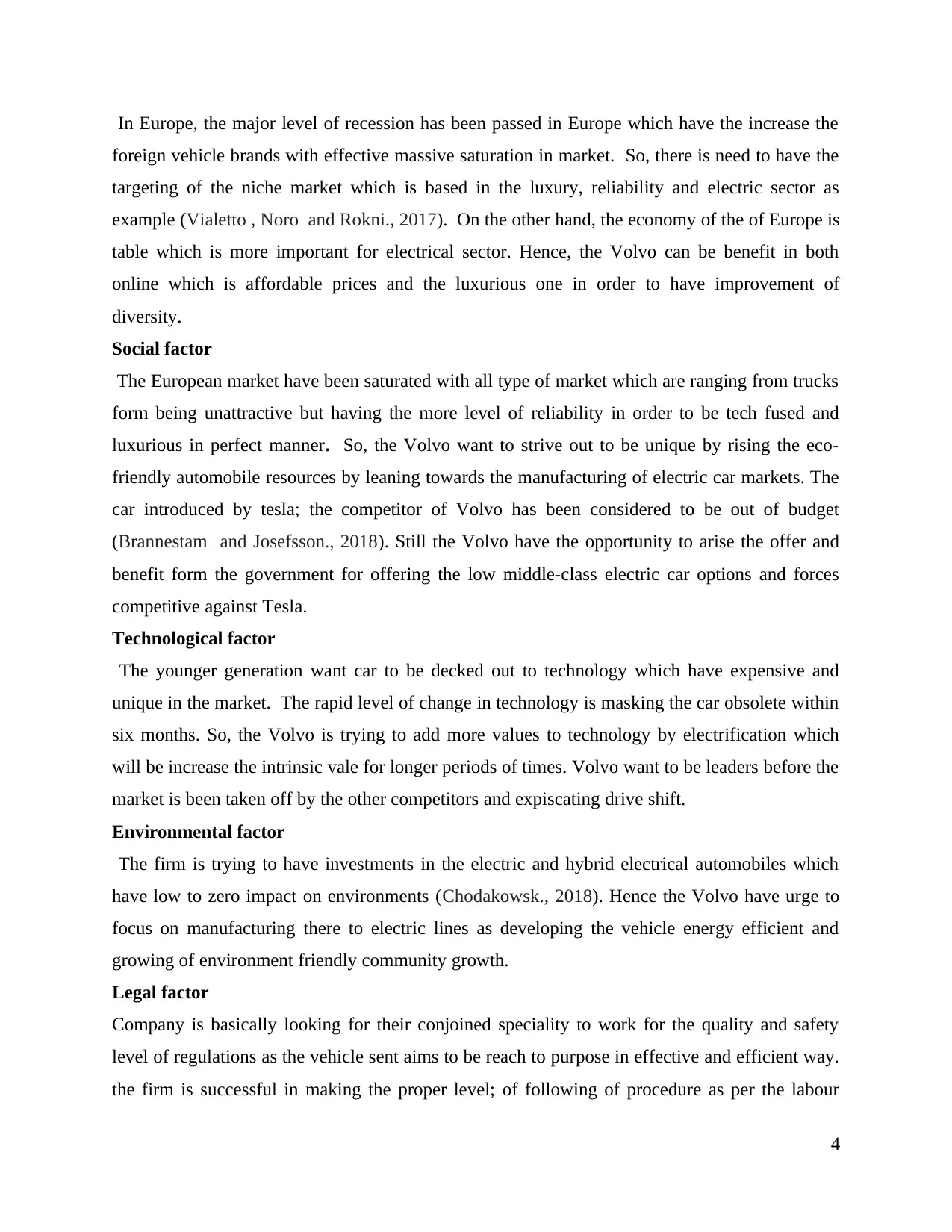
In Europe, the major level of recession has been passed in Europe which have the increase the
foreign vehicle brands with effective massive saturation in market. So, there is need to have the
targeting of the niche market which is based in the luxury, reliability and electric sector as
example (Vialetto , Noro and Rokni., 2017). On the other hand, the economy of the of Europe is
table which is more important for electrical sector. Hence, the Volvo can be benefit in both
online which is affordable prices and the luxurious one in order to have improvement of
diversity.
Social factor
The European market have been saturated with all type of market which are ranging from trucks
form being unattractive but having the more level of reliability in order to be tech fused and
luxurious in perfect manner. So, the Volvo want to strive out to be unique by rising the eco-
friendly automobile resources by leaning towards the manufacturing of electric car markets. The
car introduced by tesla; the competitor of Volvo has been considered to be out of budget
(Brannestam and Josefsson., 2018). Still the Volvo have the opportunity to arise the offer and
benefit form the government for offering the low middle-class electric car options and forces
competitive against Tesla.
Technological factor
The younger generation want car to be decked out to technology which have expensive and
unique in the market. The rapid level of change in technology is masking the car obsolete within
six months. So, the Volvo is trying to add more values to technology by electrification which
will be increase the intrinsic vale for longer periods of times. Volvo want to be leaders before the
market is been taken off by the other competitors and expiscating drive shift.
Environmental factor
The firm is trying to have investments in the electric and hybrid electrical automobiles which
have low to zero impact on environments (Chodakowsk., 2018). Hence the Volvo have urge to
focus on manufacturing there to electric lines as developing the vehicle energy efficient and
growing of environment friendly community growth.
Legal factor
Company is basically looking for their conjoined speciality to work for the quality and safety
level of regulations as the vehicle sent aims to be reach to purpose in effective and efficient way.
the firm is successful in making the proper level; of following of procedure as per the labour
4
foreign vehicle brands with effective massive saturation in market. So, there is need to have the
targeting of the niche market which is based in the luxury, reliability and electric sector as
example (Vialetto , Noro and Rokni., 2017). On the other hand, the economy of the of Europe is
table which is more important for electrical sector. Hence, the Volvo can be benefit in both
online which is affordable prices and the luxurious one in order to have improvement of
diversity.
Social factor
The European market have been saturated with all type of market which are ranging from trucks
form being unattractive but having the more level of reliability in order to be tech fused and
luxurious in perfect manner. So, the Volvo want to strive out to be unique by rising the eco-
friendly automobile resources by leaning towards the manufacturing of electric car markets. The
car introduced by tesla; the competitor of Volvo has been considered to be out of budget
(Brannestam and Josefsson., 2018). Still the Volvo have the opportunity to arise the offer and
benefit form the government for offering the low middle-class electric car options and forces
competitive against Tesla.
Technological factor
The younger generation want car to be decked out to technology which have expensive and
unique in the market. The rapid level of change in technology is masking the car obsolete within
six months. So, the Volvo is trying to add more values to technology by electrification which
will be increase the intrinsic vale for longer periods of times. Volvo want to be leaders before the
market is been taken off by the other competitors and expiscating drive shift.
Environmental factor
The firm is trying to have investments in the electric and hybrid electrical automobiles which
have low to zero impact on environments (Chodakowsk., 2018). Hence the Volvo have urge to
focus on manufacturing there to electric lines as developing the vehicle energy efficient and
growing of environment friendly community growth.
Legal factor
Company is basically looking for their conjoined speciality to work for the quality and safety
level of regulations as the vehicle sent aims to be reach to purpose in effective and efficient way.
the firm is successful in making the proper level; of following of procedure as per the labour
4
Secure Best Marks with AI Grader
Need help grading? Try our AI Grader for instant feedback on your assignments.
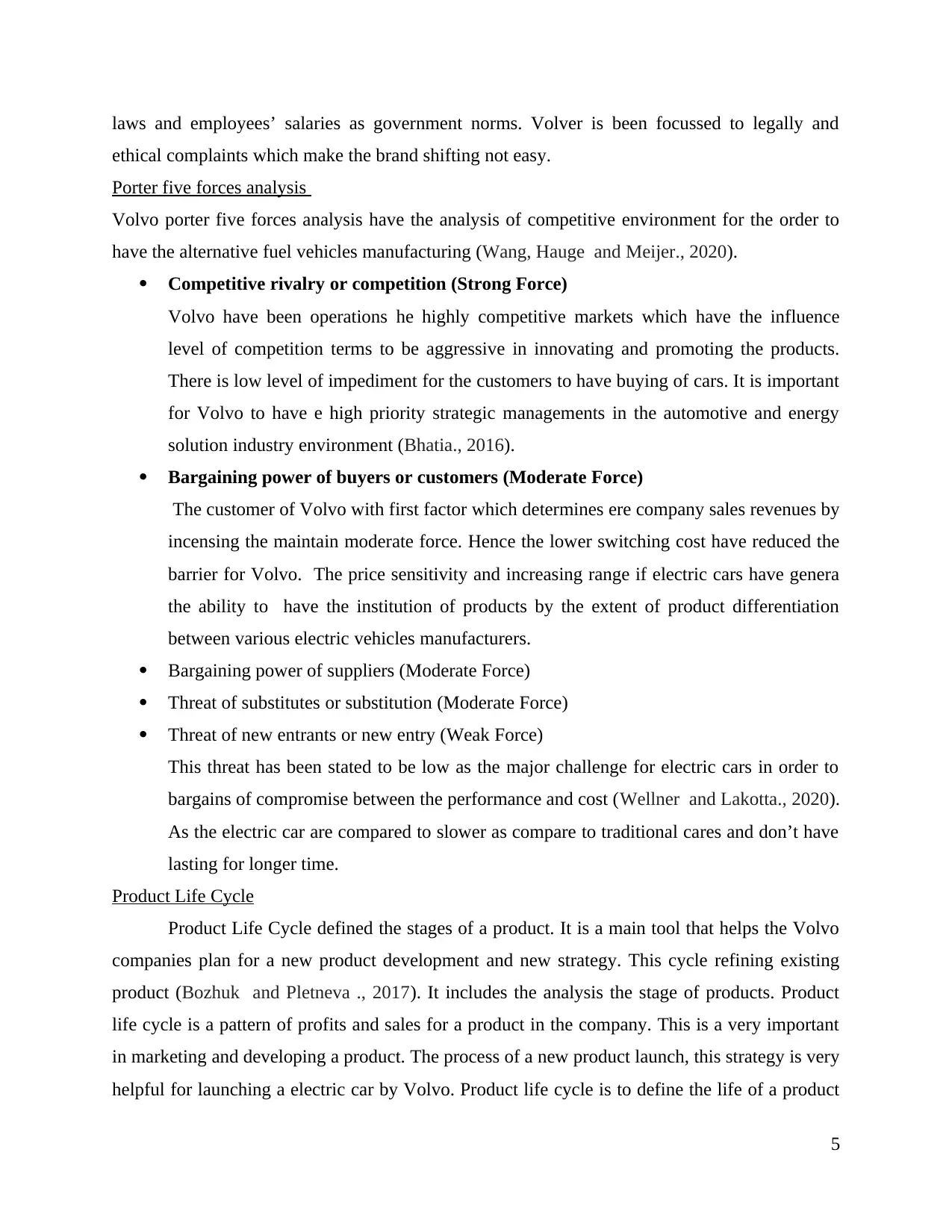
laws and employees’ salaries as government norms. Volver is been focussed to legally and
ethical complaints which make the brand shifting not easy.
Porter five forces analysis
Volvo porter five forces analysis have the analysis of competitive environment for the order to
have the alternative fuel vehicles manufacturing (Wang, Hauge and Meijer., 2020).
Competitive rivalry or competition (Strong Force)
Volvo have been operations he highly competitive markets which have the influence
level of competition terms to be aggressive in innovating and promoting the products.
There is low level of impediment for the customers to have buying of cars. It is important
for Volvo to have e high priority strategic managements in the automotive and energy
solution industry environment (Bhatia., 2016).
Bargaining power of buyers or customers (Moderate Force)
The customer of Volvo with first factor which determines ere company sales revenues by
incensing the maintain moderate force. Hence the lower switching cost have reduced the
barrier for Volvo. The price sensitivity and increasing range if electric cars have genera
the ability to have the institution of products by the extent of product differentiation
between various electric vehicles manufacturers.
Bargaining power of suppliers (Moderate Force)
Threat of substitutes or substitution (Moderate Force)
Threat of new entrants or new entry (Weak Force)
This threat has been stated to be low as the major challenge for electric cars in order to
bargains of compromise between the performance and cost (Wellner and Lakotta., 2020).
As the electric car are compared to slower as compare to traditional cares and don’t have
lasting for longer time.
Product Life Cycle
Product Life Cycle defined the stages of a product. It is a main tool that helps the Volvo
companies plan for a new product development and new strategy. This cycle refining existing
product (Bozhuk and Pletneva ., 2017). It includes the analysis the stage of products. Product
life cycle is a pattern of profits and sales for a product in the company. This is a very important
in marketing and developing a product. The process of a new product launch, this strategy is very
helpful for launching a electric car by Volvo. Product life cycle is to define the life of a product
5
ethical complaints which make the brand shifting not easy.
Porter five forces analysis
Volvo porter five forces analysis have the analysis of competitive environment for the order to
have the alternative fuel vehicles manufacturing (Wang, Hauge and Meijer., 2020).
Competitive rivalry or competition (Strong Force)
Volvo have been operations he highly competitive markets which have the influence
level of competition terms to be aggressive in innovating and promoting the products.
There is low level of impediment for the customers to have buying of cars. It is important
for Volvo to have e high priority strategic managements in the automotive and energy
solution industry environment (Bhatia., 2016).
Bargaining power of buyers or customers (Moderate Force)
The customer of Volvo with first factor which determines ere company sales revenues by
incensing the maintain moderate force. Hence the lower switching cost have reduced the
barrier for Volvo. The price sensitivity and increasing range if electric cars have genera
the ability to have the institution of products by the extent of product differentiation
between various electric vehicles manufacturers.
Bargaining power of suppliers (Moderate Force)
Threat of substitutes or substitution (Moderate Force)
Threat of new entrants or new entry (Weak Force)
This threat has been stated to be low as the major challenge for electric cars in order to
bargains of compromise between the performance and cost (Wellner and Lakotta., 2020).
As the electric car are compared to slower as compare to traditional cares and don’t have
lasting for longer time.
Product Life Cycle
Product Life Cycle defined the stages of a product. It is a main tool that helps the Volvo
companies plan for a new product development and new strategy. This cycle refining existing
product (Bozhuk and Pletneva ., 2017). It includes the analysis the stage of products. Product
life cycle is a pattern of profits and sales for a product in the company. This is a very important
in marketing and developing a product. The process of a new product launch, this strategy is very
helpful for launching a electric car by Volvo. Product life cycle is to define the life of a product
5
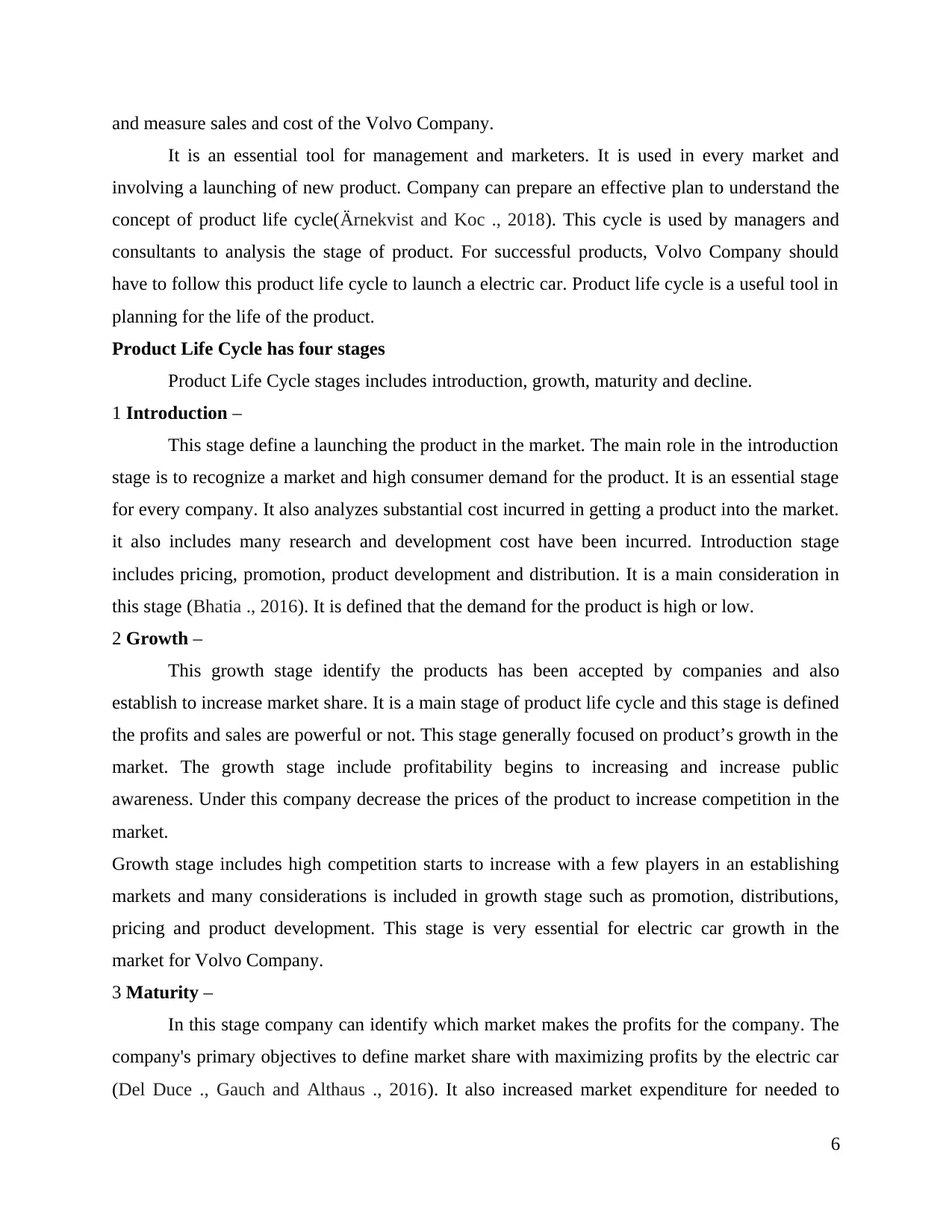
and measure sales and cost of the Volvo Company.
It is an essential tool for management and marketers. It is used in every market and
involving a launching of new product. Company can prepare an effective plan to understand the
concept of product life cycle(Ärnekvist and Koc ., 2018). This cycle is used by managers and
consultants to analysis the stage of product. For successful products, Volvo Company should
have to follow this product life cycle to launch a electric car. Product life cycle is a useful tool in
planning for the life of the product.
Product Life Cycle has four stages
Product Life Cycle stages includes introduction, growth, maturity and decline.
1 Introduction –
This stage define a launching the product in the market. The main role in the introduction
stage is to recognize a market and high consumer demand for the product. It is an essential stage
for every company. It also analyzes substantial cost incurred in getting a product into the market.
it also includes many research and development cost have been incurred. Introduction stage
includes pricing, promotion, product development and distribution. It is a main consideration in
this stage (Bhatia ., 2016). It is defined that the demand for the product is high or low.
2 Growth –
This growth stage identify the products has been accepted by companies and also
establish to increase market share. It is a main stage of product life cycle and this stage is defined
the profits and sales are powerful or not. This stage generally focused on product’s growth in the
market. The growth stage include profitability begins to increasing and increase public
awareness. Under this company decrease the prices of the product to increase competition in the
market.
Growth stage includes high competition starts to increase with a few players in an establishing
markets and many considerations is included in growth stage such as promotion, distributions,
pricing and product development. This stage is very essential for electric car growth in the
market for Volvo Company.
3 Maturity –
In this stage company can identify which market makes the profits for the company. The
company's primary objectives to define market share with maximizing profits by the electric car
(Del Duce ., Gauch and Althaus ., 2016). It also increased market expenditure for needed to
6
It is an essential tool for management and marketers. It is used in every market and
involving a launching of new product. Company can prepare an effective plan to understand the
concept of product life cycle(Ärnekvist and Koc ., 2018). This cycle is used by managers and
consultants to analysis the stage of product. For successful products, Volvo Company should
have to follow this product life cycle to launch a electric car. Product life cycle is a useful tool in
planning for the life of the product.
Product Life Cycle has four stages
Product Life Cycle stages includes introduction, growth, maturity and decline.
1 Introduction –
This stage define a launching the product in the market. The main role in the introduction
stage is to recognize a market and high consumer demand for the product. It is an essential stage
for every company. It also analyzes substantial cost incurred in getting a product into the market.
it also includes many research and development cost have been incurred. Introduction stage
includes pricing, promotion, product development and distribution. It is a main consideration in
this stage (Bhatia ., 2016). It is defined that the demand for the product is high or low.
2 Growth –
This growth stage identify the products has been accepted by companies and also
establish to increase market share. It is a main stage of product life cycle and this stage is defined
the profits and sales are powerful or not. This stage generally focused on product’s growth in the
market. The growth stage include profitability begins to increasing and increase public
awareness. Under this company decrease the prices of the product to increase competition in the
market.
Growth stage includes high competition starts to increase with a few players in an establishing
markets and many considerations is included in growth stage such as promotion, distributions,
pricing and product development. This stage is very essential for electric car growth in the
market for Volvo Company.
3 Maturity –
In this stage company can identify which market makes the profits for the company. The
company's primary objectives to define market share with maximizing profits by the electric car
(Del Duce ., Gauch and Althaus ., 2016). It also increased market expenditure for needed to
6
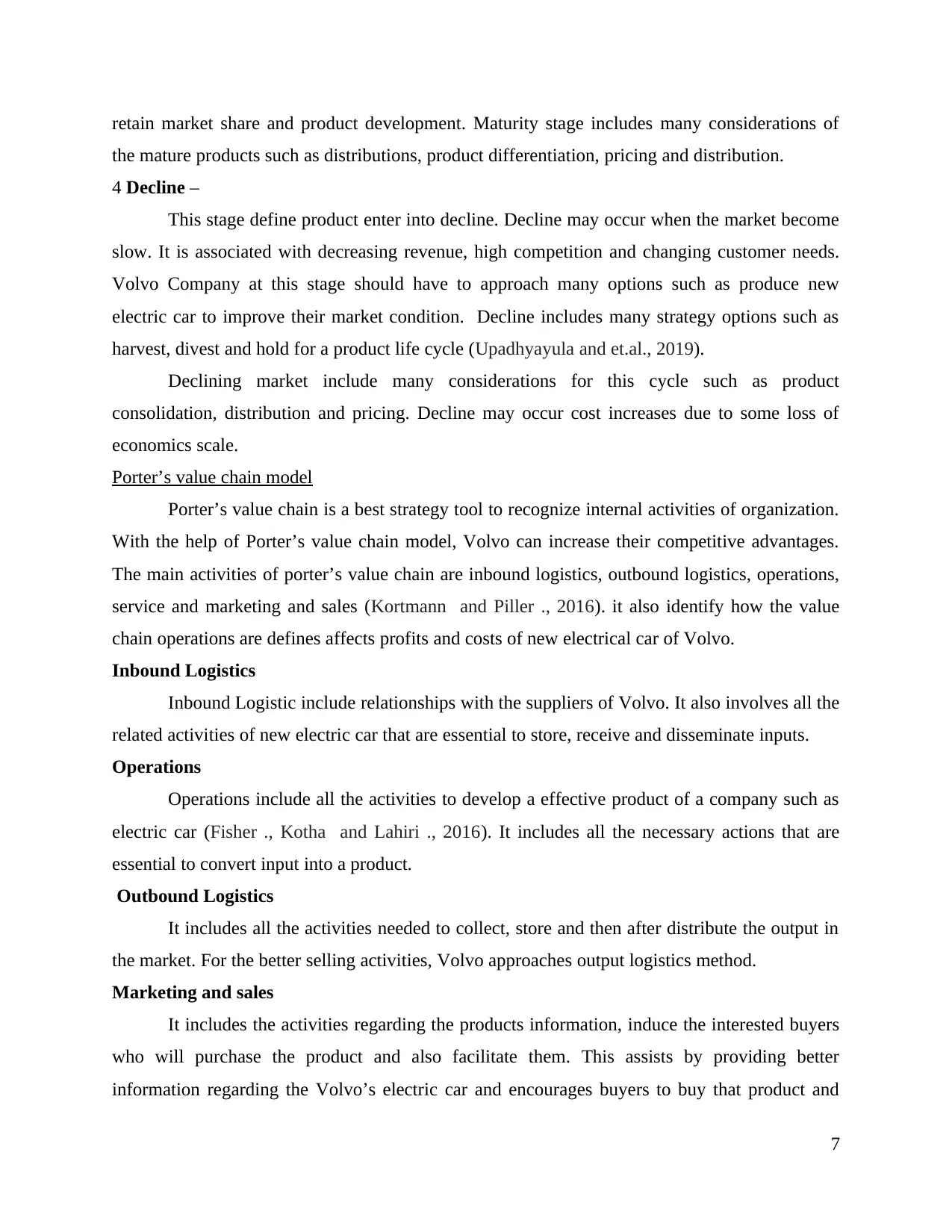
retain market share and product development. Maturity stage includes many considerations of
the mature products such as distributions, product differentiation, pricing and distribution.
4 Decline –
This stage define product enter into decline. Decline may occur when the market become
slow. It is associated with decreasing revenue, high competition and changing customer needs.
Volvo Company at this stage should have to approach many options such as produce new
electric car to improve their market condition. Decline includes many strategy options such as
harvest, divest and hold for a product life cycle (Upadhyayula and et.al., 2019).
Declining market include many considerations for this cycle such as product
consolidation, distribution and pricing. Decline may occur cost increases due to some loss of
economics scale.
Porter’s value chain model
Porter’s value chain is a best strategy tool to recognize internal activities of organization.
With the help of Porter’s value chain model, Volvo can increase their competitive advantages.
The main activities of porter’s value chain are inbound logistics, outbound logistics, operations,
service and marketing and sales (Kortmann and Piller ., 2016). it also identify how the value
chain operations are defines affects profits and costs of new electrical car of Volvo.
Inbound Logistics
Inbound Logistic include relationships with the suppliers of Volvo. It also involves all the
related activities of new electric car that are essential to store, receive and disseminate inputs.
Operations
Operations include all the activities to develop a effective product of a company such as
electric car (Fisher ., Kotha and Lahiri ., 2016). It includes all the necessary actions that are
essential to convert input into a product.
Outbound Logistics
It includes all the activities needed to collect, store and then after distribute the output in
the market. For the better selling activities, Volvo approaches output logistics method.
Marketing and sales
It includes the activities regarding the products information, induce the interested buyers
who will purchase the product and also facilitate them. This assists by providing better
information regarding the Volvo’s electric car and encourages buyers to buy that product and
7
the mature products such as distributions, product differentiation, pricing and distribution.
4 Decline –
This stage define product enter into decline. Decline may occur when the market become
slow. It is associated with decreasing revenue, high competition and changing customer needs.
Volvo Company at this stage should have to approach many options such as produce new
electric car to improve their market condition. Decline includes many strategy options such as
harvest, divest and hold for a product life cycle (Upadhyayula and et.al., 2019).
Declining market include many considerations for this cycle such as product
consolidation, distribution and pricing. Decline may occur cost increases due to some loss of
economics scale.
Porter’s value chain model
Porter’s value chain is a best strategy tool to recognize internal activities of organization.
With the help of Porter’s value chain model, Volvo can increase their competitive advantages.
The main activities of porter’s value chain are inbound logistics, outbound logistics, operations,
service and marketing and sales (Kortmann and Piller ., 2016). it also identify how the value
chain operations are defines affects profits and costs of new electrical car of Volvo.
Inbound Logistics
Inbound Logistic include relationships with the suppliers of Volvo. It also involves all the
related activities of new electric car that are essential to store, receive and disseminate inputs.
Operations
Operations include all the activities to develop a effective product of a company such as
electric car (Fisher ., Kotha and Lahiri ., 2016). It includes all the necessary actions that are
essential to convert input into a product.
Outbound Logistics
It includes all the activities needed to collect, store and then after distribute the output in
the market. For the better selling activities, Volvo approaches output logistics method.
Marketing and sales
It includes the activities regarding the products information, induce the interested buyers
who will purchase the product and also facilitate them. This assists by providing better
information regarding the Volvo’s electric car and encourages buyers to buy that product and
7
Paraphrase This Document
Need a fresh take? Get an instant paraphrase of this document with our AI Paraphraser
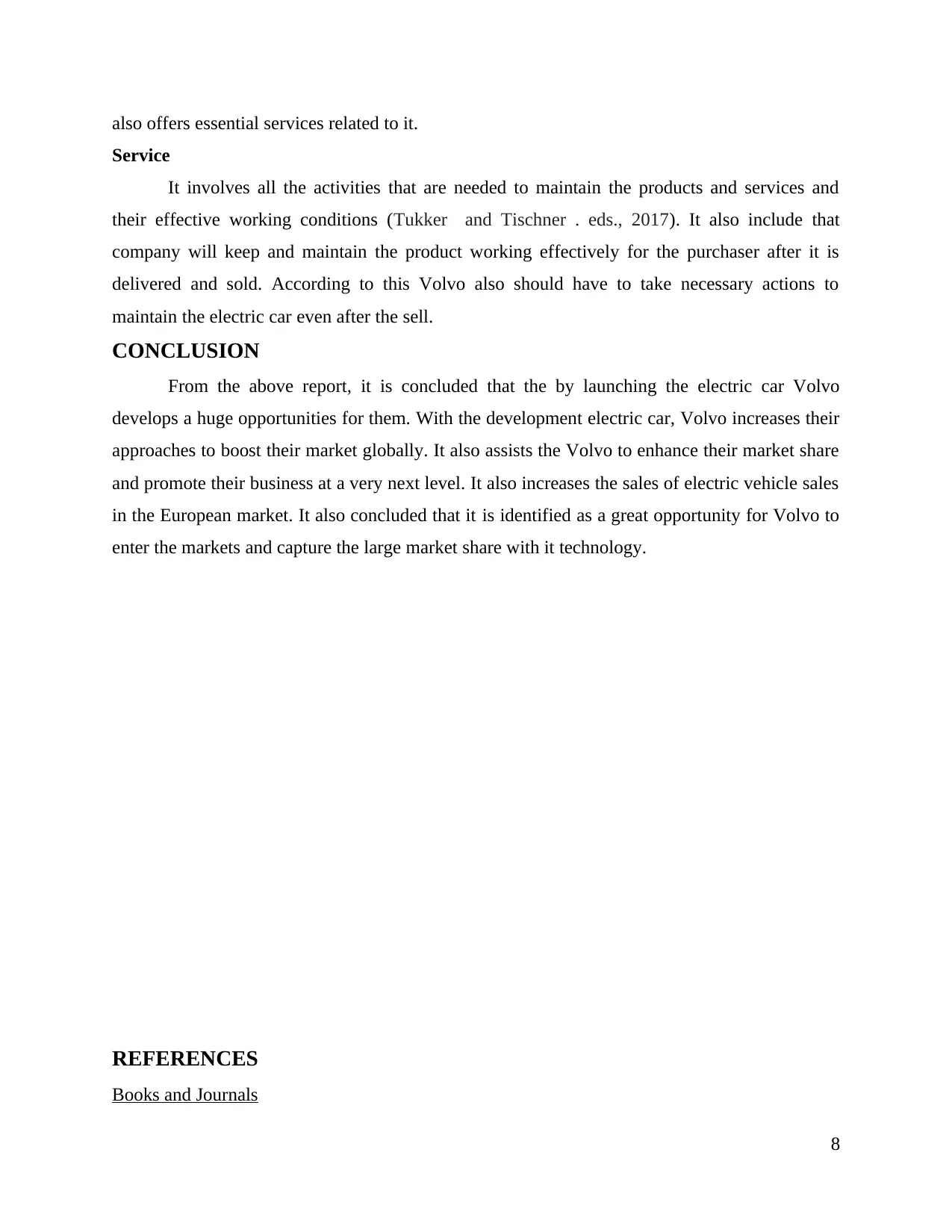
also offers essential services related to it.
Service
It involves all the activities that are needed to maintain the products and services and
their effective working conditions (Tukker and Tischner . eds., 2017). It also include that
company will keep and maintain the product working effectively for the purchaser after it is
delivered and sold. According to this Volvo also should have to take necessary actions to
maintain the electric car even after the sell.
CONCLUSION
From the above report, it is concluded that the by launching the electric car Volvo
develops a huge opportunities for them. With the development electric car, Volvo increases their
approaches to boost their market globally. It also assists the Volvo to enhance their market share
and promote their business at a very next level. It also increases the sales of electric vehicle sales
in the European market. It also concluded that it is identified as a great opportunity for Volvo to
enter the markets and capture the large market share with it technology.
REFERENCES
Books and Journals
8
Service
It involves all the activities that are needed to maintain the products and services and
their effective working conditions (Tukker and Tischner . eds., 2017). It also include that
company will keep and maintain the product working effectively for the purchaser after it is
delivered and sold. According to this Volvo also should have to take necessary actions to
maintain the electric car even after the sell.
CONCLUSION
From the above report, it is concluded that the by launching the electric car Volvo
develops a huge opportunities for them. With the development electric car, Volvo increases their
approaches to boost their market globally. It also assists the Volvo to enhance their market share
and promote their business at a very next level. It also increases the sales of electric vehicle sales
in the European market. It also concluded that it is identified as a great opportunity for Volvo to
enter the markets and capture the large market share with it technology.
REFERENCES
Books and Journals
8
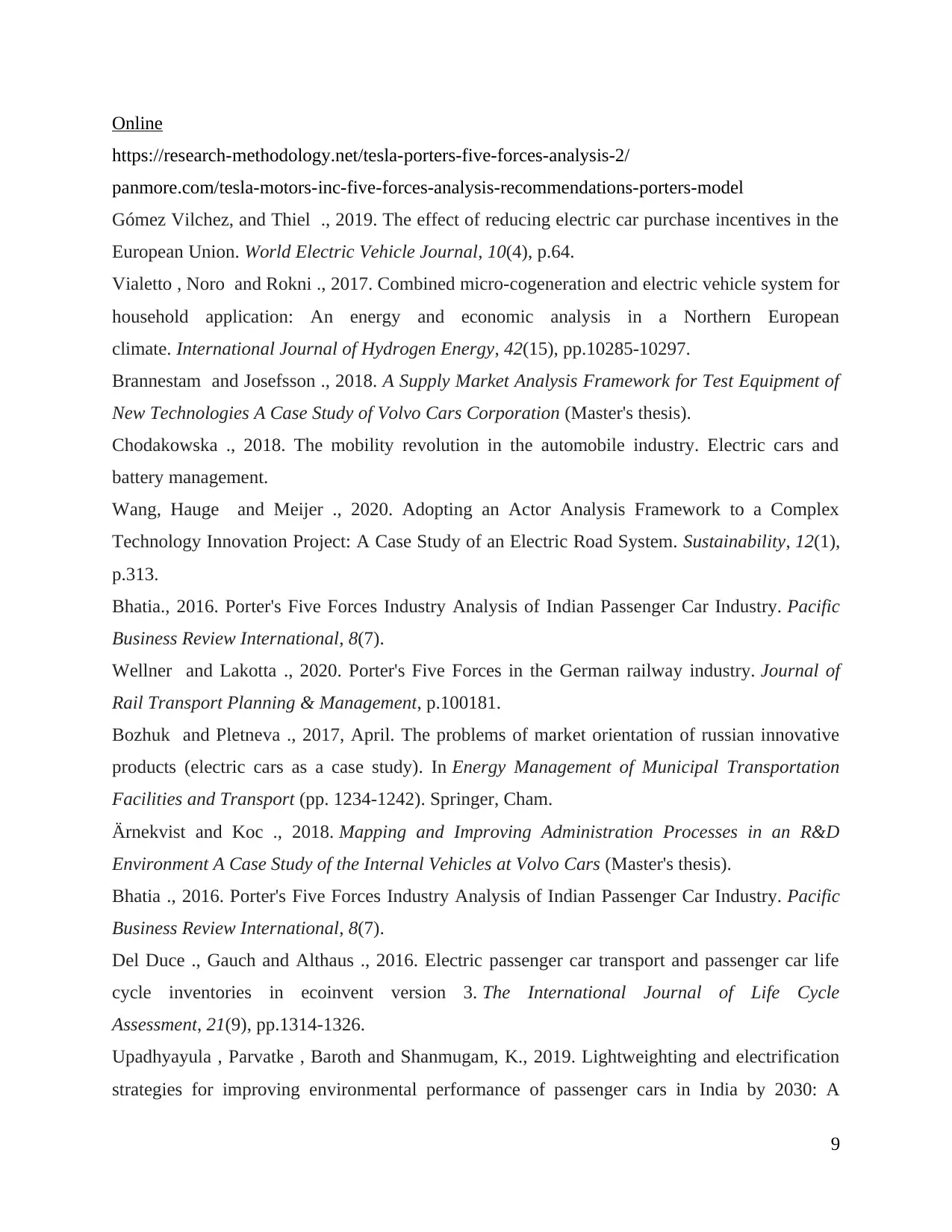
Online
https://research-methodology.net/tesla-porters-five-forces-analysis-2/
panmore.com/tesla-motors-inc-five-forces-analysis-recommendations-porters-model
Gómez Vilchez, and Thiel ., 2019. The effect of reducing electric car purchase incentives in the
European Union. World Electric Vehicle Journal, 10(4), p.64.
Vialetto , Noro and Rokni ., 2017. Combined micro-cogeneration and electric vehicle system for
household application: An energy and economic analysis in a Northern European
climate. International Journal of Hydrogen Energy, 42(15), pp.10285-10297.
Brannestam and Josefsson ., 2018. A Supply Market Analysis Framework for Test Equipment of
New Technologies A Case Study of Volvo Cars Corporation (Master's thesis).
Chodakowska ., 2018. The mobility revolution in the automobile industry. Electric cars and
battery management.
Wang, Hauge and Meijer ., 2020. Adopting an Actor Analysis Framework to a Complex
Technology Innovation Project: A Case Study of an Electric Road System. Sustainability, 12(1),
p.313.
Bhatia., 2016. Porter's Five Forces Industry Analysis of Indian Passenger Car Industry. Pacific
Business Review International, 8(7).
Wellner and Lakotta ., 2020. Porter's Five Forces in the German railway industry. Journal of
Rail Transport Planning & Management, p.100181.
Bozhuk and Pletneva ., 2017, April. The problems of market orientation of russian innovative
products (electric cars as a case study). In Energy Management of Municipal Transportation
Facilities and Transport (pp. 1234-1242). Springer, Cham.
Ärnekvist and Koc ., 2018. Mapping and Improving Administration Processes in an R&D
Environment A Case Study of the Internal Vehicles at Volvo Cars (Master's thesis).
Bhatia ., 2016. Porter's Five Forces Industry Analysis of Indian Passenger Car Industry. Pacific
Business Review International, 8(7).
Del Duce ., Gauch and Althaus ., 2016. Electric passenger car transport and passenger car life
cycle inventories in ecoinvent version 3. The International Journal of Life Cycle
Assessment, 21(9), pp.1314-1326.
Upadhyayula , Parvatke , Baroth and Shanmugam, K., 2019. Lightweighting and electrification
strategies for improving environmental performance of passenger cars in India by 2030: A
9
https://research-methodology.net/tesla-porters-five-forces-analysis-2/
panmore.com/tesla-motors-inc-five-forces-analysis-recommendations-porters-model
Gómez Vilchez, and Thiel ., 2019. The effect of reducing electric car purchase incentives in the
European Union. World Electric Vehicle Journal, 10(4), p.64.
Vialetto , Noro and Rokni ., 2017. Combined micro-cogeneration and electric vehicle system for
household application: An energy and economic analysis in a Northern European
climate. International Journal of Hydrogen Energy, 42(15), pp.10285-10297.
Brannestam and Josefsson ., 2018. A Supply Market Analysis Framework for Test Equipment of
New Technologies A Case Study of Volvo Cars Corporation (Master's thesis).
Chodakowska ., 2018. The mobility revolution in the automobile industry. Electric cars and
battery management.
Wang, Hauge and Meijer ., 2020. Adopting an Actor Analysis Framework to a Complex
Technology Innovation Project: A Case Study of an Electric Road System. Sustainability, 12(1),
p.313.
Bhatia., 2016. Porter's Five Forces Industry Analysis of Indian Passenger Car Industry. Pacific
Business Review International, 8(7).
Wellner and Lakotta ., 2020. Porter's Five Forces in the German railway industry. Journal of
Rail Transport Planning & Management, p.100181.
Bozhuk and Pletneva ., 2017, April. The problems of market orientation of russian innovative
products (electric cars as a case study). In Energy Management of Municipal Transportation
Facilities and Transport (pp. 1234-1242). Springer, Cham.
Ärnekvist and Koc ., 2018. Mapping and Improving Administration Processes in an R&D
Environment A Case Study of the Internal Vehicles at Volvo Cars (Master's thesis).
Bhatia ., 2016. Porter's Five Forces Industry Analysis of Indian Passenger Car Industry. Pacific
Business Review International, 8(7).
Del Duce ., Gauch and Althaus ., 2016. Electric passenger car transport and passenger car life
cycle inventories in ecoinvent version 3. The International Journal of Life Cycle
Assessment, 21(9), pp.1314-1326.
Upadhyayula , Parvatke , Baroth and Shanmugam, K., 2019. Lightweighting and electrification
strategies for improving environmental performance of passenger cars in India by 2030: A
9

critical perspective based on life cycle assessment. Journal of cleaner production, 209, pp.1604-
1613.
Kortmann and Piller ., 2016. Open business models and closed-loop value chains: Redefining
the firm-consumer relationship. California Management Review, 58(3), pp.88-108.
Fisher ., Kotha and Lahiri ., 2016. Changing with the times: An integrated view of identity,
legitimacy, and new venture life cycles. Academy of Management Review, 41(3), pp.383-409.
Tukker and Tischner . eds., 2017. New business for old Europe: product-service development,
competitiveness and sustainability.
10
1613.
Kortmann and Piller ., 2016. Open business models and closed-loop value chains: Redefining
the firm-consumer relationship. California Management Review, 58(3), pp.88-108.
Fisher ., Kotha and Lahiri ., 2016. Changing with the times: An integrated view of identity,
legitimacy, and new venture life cycles. Academy of Management Review, 41(3), pp.383-409.
Tukker and Tischner . eds., 2017. New business for old Europe: product-service development,
competitiveness and sustainability.
10
Secure Best Marks with AI Grader
Need help grading? Try our AI Grader for instant feedback on your assignments.

11

12
1 out of 12
Related Documents
Your All-in-One AI-Powered Toolkit for Academic Success.
+13062052269
info@desklib.com
Available 24*7 on WhatsApp / Email
![[object Object]](/_next/static/media/star-bottom.7253800d.svg)
Unlock your academic potential
© 2024 | Zucol Services PVT LTD | All rights reserved.





